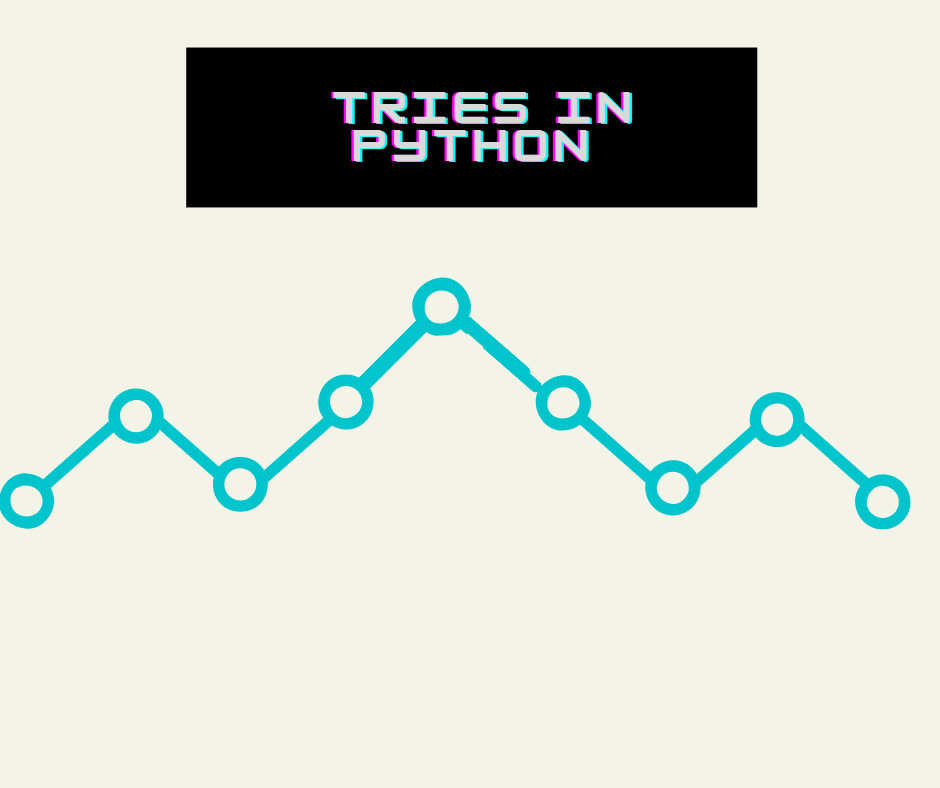Python trie is a data structure that was designed to help you find the longest common subsequence of two sequences. It works by scanning through the input sequences and checking for any common prefixes or suffixes; if it finds one, it returns the corresponding value. If you want to know more about how Python tries.trie works, then read on!
Tries are a data structure for efficiently searching for a key in a sorted ordered array. The array is indexed by keys, and the index of the key to be matched is specified by the first element of the lookup table.
More about Tries
Python tries, the Python equivalent of a trie, is a data structure that stores the string in an array of pointers. In other words, it is a linked list of pointers to strings.
A trie is an efficient search engine for strings that has no explicit lookup table and is therefore very fast. It has been used to solve many problems in computer science and data mining. The “lookup” function is similar to indexing into an array but it uses only one string instead of many strings.
The trie implemented in Python uses the same algorithms as binary trees, but with one major difference: it does not use pointers directly in its implementation but rather uses objects with special methods for searching and splitting strings into substrings. This means that there are no objects in Python code that refer directly to other objects (as with standard tree data structures), so memory management is easier because each object can have its own dictionary containing references to other objects it needs at runtime—or none at all!
trie module in Python

Python trie is a data structure that implements a trie. It can be used to store text strings. The structure consists of nodes with values associated with them. The nodes are arranged in a tree-like structure. Each node has an integer value and a string associated with it. The Python trie class implements the following methods:
__init__() – Initialize the class
lookup() – Return the key associated with the given string
insert() – Insert a new node at the specified index into the tree
delete() – Delete the node with the specified key from the tree
Basic Operations in trie
Here, we can map the letter that is searched to a new child node with the help of a trie.
class Trie(object):
def __init__(self):
self.child = {}
def insert(self, word):
current = self.child
for l in word:
if l not in current:
current[l] = {}
current = current[l]
current['#']=1
def search(self, word):
current = self.child
for l in word:
if l not in current:
return False
current = current[l]
return '#' in current
def startsWith(self, prefix):
current = self.child
for l in prefix:
if l not in current:
return False
current = current[l]
return True
#create an object of trie
obj= Trie()
obj.insert("apple")
print(obj.search("apple"))
print(obj.search("app"))
print(obj.startsWith("app"))
obj.insert("app")
print(obj.search("app"))
#Output will be :
#True
#False
#True
#True
Prefix Searching/ Matching in tries
Here, you need to check the whole list and see where the pattern exists. pytrie.StringTrie() module will help in matching a pattern using trie data structure.
pip install pytrie –user
#use this to implement pytrie module
from pytrie import StringTrie
def SearchP(arr,prefix):
trie=StringTrie()
# create a trie structure
for key in arr:
trie[key] = key
return trie.values(prefix)
#return list of values
#main function
if __name__ == "__main__":
Myarr = ['python','pythonblog','blogpython']
pre = 'bl'
res = SearchP(Myarr,pre)
if len(res) > 0:
print (res)
else:
print ('Pattern not found')
We can create a trie for pattern matching, check if the length of matched string matches the prefix, and then display the output.
Trie with defaultdict and recursion
It uses recursion.
from collections import defaultdict
def node():
return defaultdict(node)
def word_exists(word, node):
if not word:
return None in node
return word_exists(word[1:], node[word[0]])
def add_word(word, node):
if not word:
# terminal letter of the word
node[None]
return
add_word(word[1:], node[word[0]])
#create a WordDictionary object
# myobj= WordDictionary()
# myobj.addWord(word)
# pythonpool= obj.search(word)
Trie vs Dictionary and Hash Table
A hash table can be implemented easily. Its search time always stays the same. Be it insertion, searching, or deletion, the time complexity is always O(1). It is highly efficient but at the same time, it can have many collisions. Also, you can not add null values to a hash table.
On the other hand, tries don’t need a hash function to work. As stated above, we can do pattern matching and prefix matching with tries in Python. It reduces the time needed for overheads, too. However, it takes a lot of memory space to keep the strings that we have added to the trie data structure. A hash table might work faster than trie in case it has better and well-developed hash functions.
The time complexity of Trie methods
Usually, the time complexity is O(m) for basic trie functions like searching for a prefix, removing, and inserting. This contrasts the complexity of Binary search trees, which is O(m*log(n)).
Python Tries vs Trees
Tries are different from trees in a couple of ways. Tries help to reduce redundancy by joining words with common letters through a root node. In other words, a trie stores only common prefixes, so it reduces the overhead of searching the same prefix again and again till we find the exact same letter.
Contrary to the tries approach, trees may have redundant data. All words are compared to the word which has to be found. So there are high chances of repetition.
Hence, tries to work better with prefixed words. Also, you may approach a hash table to search for a word because a hash table works faster than a trie. Tries have issues with storing floating point numbers, too, so you may consider this as a drawback of tries.
FAQs
Yes, tries can be used for this purpose.
Tries can be used with the pygtrie library in Python. It is in-built.
We can use recursion to implement this. Maintain a new string that adds all primary nodes and repeat this till you reach a leaf node.
Conclusion
With the help of this article, you must have got to know how Python tries to work. Apart from this, we also covered pattern matching with tries.
References
Trie Implementation using defaultdict. GitHub (crlane).

![[Fixed] typeerror can’t compare datetime.datetime to datetime.date](https://www.pythonpool.com/wp-content/uploads/2024/01/typeerror-cant-compare-datetime.datetime-to-datetime.date_-300x157.webp)
![[Fixed] nameerror: name Unicode is not defined](https://www.pythonpool.com/wp-content/uploads/2024/01/Fixed-nameerror-name-Unicode-is-not-defined-300x157.webp)
![[Solved] runtimeerror: cuda error: invalid device ordinal](https://www.pythonpool.com/wp-content/uploads/2024/01/Solved-runtimeerror-cuda-error-invalid-device-ordinal-300x157.webp)
![[Fixed] typeerror: type numpy.ndarray doesn’t define __round__ method](https://www.pythonpool.com/wp-content/uploads/2024/01/Fixed-typeerror-type-numpy.ndarray-doesnt-define-__round__-method-300x157.webp)